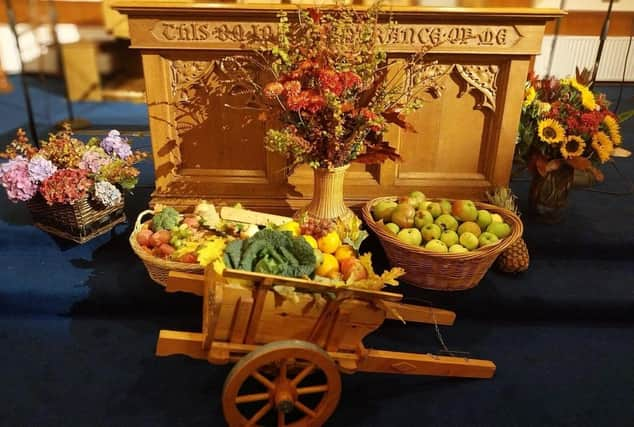Ian Ellis: Harvest thanksgiving – a time to come together and express gratitude for all that has been gathered in


I have completely lost count of the number of harvest thanksgiving sermons I have preached.
It has been a long tradition, in the Church of Ireland at least, to have a visiting preacher for the occasion, so most of those sermons were not preached in my own parish, but out and about.
Advertisement
Hide AdAdvertisement
Hide AdThere are many different aspects of the harvest theme, such as the wonder of creation's 'seed-time and harvest'; the harvest of the sea as well as of the land; the need to remember the plight of those who have had a lesser, if even not non-existent, harvest; the Christian spiritual parallels of 'sowing the word' and Christ as 'the bread of life'.
Other religions similarly recognise the blessing of harvest, such as the Jewish Sukkot celebration, which also recalls the forty years the Jews spent in the wilderness after having been delivered from bondage in Egypt.
Indeed, the recent devastating Hamas attack on Israel came just as the Sukkot celebration period was ending.
Muslims and Buddhists have ceremonies on the theme of the sharing of God's bounty.
Advertisement
Hide AdAdvertisement
Hide AdThat is central to any thanksgiving for harvest because the celebration also involves remembering those who have been less fortunate in their harvests, and recognising the duty to help them in practical ways.
So, a preacher has plenty of scope at harvest services.
Often associated with the service is a harvest supper, which in turn followed an earlier tradition of farm owners inviting those who had worked the harvest to a special meal.
We all depend on the farmers for our food but modern urban life can obscure that basic fact.
Harvest time is part of what is now known in many church circles as the 'Season of Creation', when the theme includes such modern issues as biodiversity and climate concerns.
Advertisement
Hide AdAdvertisement
Hide AdIndeed, as reported in the News Letter (Archbishops in call for Lough Neagh task force, September 20), Archbishops of Armagh John McDowell and Eamon Martin, in the spirit of the Season of Creation, have recently spoken out about the environmental situation in Lough Neagh.
In a joint statement they said: "This impressive body of water – the largest freshwater lake in these islands – is facing a dire threat from toxic blue-green algae. Collectively, we are endangering a natural asset that provides water to hundreds of thousands of families across Northern Ireland, sustains diverse fish varieties, supports wildlife and offers employment opportunities to thousands of people across the area."
Warning of an impending "environmental disaster", the church leaders called for urgent action in the form of "a robust plan to save this unique and ancient ecosystem".
Advertisement
Hide AdAdvertisement
Hide AdIt was a striking intervention that reflected Christian concern for creation itself.
Unsurprisingly, Northern Ireland is officially classed as predominantly rural.
The Department of Agriculture, Environment and Rural Affairs (DAERA), in its report 'Key Rural Issues, Northern Ireland 2022', referred to how the Northern Ireland Statistics and Research Agency had carried out a review of settlement classification in 2015, which recommended a default urban/rural boundary at a population level of 5,000, with all settlements with a population of less than 5,000, and areas of open countryside, being defined as rural.
The DEARA report states that under the 2015 settlement classification definition, more than 80 percent of the Northern Ireland land mass is rural.
Advertisement
Hide AdAdvertisement
Hide AdThe report also indicates that 58 percent of Northern Ireland businesses are in rural areas, although they account for only 21 percent of employment.
Nonetheless, rural businesses are also reported as accounting for around a quarter of total business turnover in Northern Ireland, engaging predominantly in the agriculture, forestry, fishing and construction industries.
Interestingly, the report highlights the fact that population growth in rural areas from 2001-20 outstripped that in urban areas by a factor of almost three to one, and indicates that young people from rural areas are more likely to leave school with five or more GCSEs at A* to C than those from urban areas (82 versus 74 percent).
Statistics are of course notoriously difficult to interpret, but from the evidence available it is absolutely clear that rural life is vitally important in many respects in Northern Ireland.
Advertisement
Hide AdAdvertisement
Hide AdA recent article by Marion McGarry of RTE has recalled that in times past there were many different customs and traditions associated with harvest on Irish farms, varying regionally across the island.
These recognised the importance of harvest for Irish people, and were observed by both Protestants and Roman Catholics, although nowadays the church harvest thanksgiving is mostly associated with the Protestant community.
Rightly, Ms McGarry adds that the present-day harvest thanksgiving services are “notable for beautiful displays of fruits and vegetables” in churches. Harvest thanksgiving is a welcome time for the community to come together and express gratitude for all that has been gathered in.
Canon Ian Ellis is a former editor of The Church of Ireland Gazette